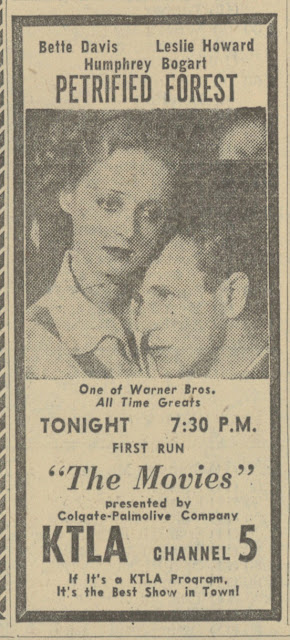Thirty Seconds Over L.A. --- Part Two
Hollywood had always been about sweeping out the old in favor of the new. Studios and showmen weren't in business to celebrate history. Sam Zimbalist was self-preserving enough to put oldies in perspective. I believe that only 10 or 15% of the movies sold to TV are really great pictures, and I'm interested in seeing what happens when the lesser product is shown. A lot of those twenty-year-old shows would look "silly and dated" now, said the still active producer. Motion Picture Herald ran with that admission in steel-tipped boots: It's always been painful to look again at old movies that we thought were good, and find out how crude they were. The enthusiasts for ancient films have done more than any others to keep motion pictures in their infancy (Ouch --- They mean us, Greenbriar readers!).
 |
It was a no-win fight what with film companies chasing respective windfalls and showmen left holding (empty) bags. Pete Harrison of his weekly Reports warned theatres not to book vintage MGM without a written guarantee that their show wouldn't turn up on local free-vee that very night. As of Fall 1956, the following "Masterpiece Reprints" were labeled smallpox: A Tale Of Two Cities, Marie Antoinette, Mutiny On The Bounty, Boy's Town, others. Even if these weren't actually being televised day-and-date with theatres, they were listed among titles forthcoming to buyer stations in lavish newspaper ads promoting pre-48 MGM's to come. Everyone knew that all came to home viewers who waited. Spokesmen for Metro tried convincing exhibs that the library's sale to TV was a good thing --- after all, think of all that free publicity via alliance with the tube, and "a rise of interest in MGM films." Such was purest banana oil that showmen would not swallow.
KTTV saw ratings drop nearly a third for its next Friday night MGM special. That was Mrs. Miniver. Further erosion came with They Met In Bombay the following week. Viewership was considered disappointing after fantastic numbers posted by Thirty Seconds Over Tokyo. One explanation for the decline is that there was less promotion for the subsequent weeks' pictures, said Billboard. Newspaper ad buys had settled down to the quarter-page class. Interesting was viewer fluctuation over the two-hour slots --- Bombay fell off sharply in its second half, whereas Miniver built up almost steadily. Movies on TV were being evaluated by thirty-minute increments, the question being less whether folks tuned in than would they stay tuned in. Still, Colgate was more than happy with "the greatest sales volume in this (LA) market of all time."
It didn't take long for KTTV, and other stations, to figure out which side old movies were buttered on. After a first season of Colgate Theater, trends were clear as Trendex figures confirming them. Said Billboard: The general rule of thumb now is that the action-adventure pictures will get ratings; comedies, musicals, problem or love stories will not (but hadn't exhibitors already known this from reissue experience? --- guess nobody asked them). Here then, was KTTV's Top Ten Metros for its first season of Colgate Theater: Thirty Seconds Over Tokyo, Honky Tonk,
It's the he-man type of star which gathers the audience, observed Billboard ... Female stars, except for the Marilyn Monroe, Jean Harlow type, are poor draws. The kings of TV's boxoffice, at least on KTTV's corner, were Clark Gable and Spencer Tracy, he-men both. Comedies and musicals were considered outdated. People just don't dig them anymore, said Billboard. As far as television is concerned ... the best musical may command less (advertising) money than only an ordinary adventure film. Competing salvage dealers meanwhile worked double-time to pull the Metro oldies off their perch. Associated Artists, distributor of the pre-48 Warners library, filed their "Most Honorable Report" trade ad, replete with a bowing Japanese caricature, to declare Destination Tokyo a bigger ratings-getter (at least in
Leo's TV Roar Now A Grunt, said Variety in a January, 1957 headline. Seems the Pre-48 Greats yielded a less than great $40 million from sales so far of the vaunted package against expectations they'd collect upwards of $60-70 million. Trouble was paucity of buyers after deep-pocket stations grabbed their marbles. Smaller markets just couldn't afford what Loew's demanded, to-wit a one-million dollar single-station tariff. Recouping that kind of money (an enormous outlay, said Variety) within a seven-year license period would be tough sledding for telecasters in secondary markets. Could they go into profit before time to send the movies back? For stations outside the largest cities, it didn't seem likely. Metro seemed to have priced their "too rich" features out of the market, and humbler outlets made do with lower-tagged product from rival sellers (NC stations were notably shy of Metros until post-48 groups came available in the sixties).
Another Thirty Seconds Over Tokyo story, too good not to mention.
One more irresistible footnote, also dated 1957. June of that year saw Thirty Seconds Over Tokyo finally opening theatrically in


















































